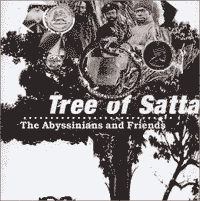
ABYSSINIANS & FRIENDS
TREE OF SATTA vol 1 (Blood & Fire 045)
It seemed inevitable that Blood & Fire would finally falter in their brilliant recouping of the legacy of reggae. TREE OF SATTA appealed to me because I love versions when there is an unstoppable rhythm at the core, and of course "Satta Massa Gana" is arguably the ultimate reggae rhythm: it has been versioned over 450 times, making it the quintessential Reggae Karaoke tune! Years ago I made a c90 cassette with half a dozen versions of this song from albums and 45s and then versions of three other Abyssinian tunes on it. Here Blood & Fire have gone for the mother rhythm and in addition to the well-known versions (Tommy McCook instrumentals & various toasters), they have commissioned new versions from up and coming reggae artists. This was a mistake. Historically the tune and its versions occupy an important place in reggae music as a visionary call to Rastafari. Before the visit of Haile Selassie to Jamaica in 1966, the former black slaves were seen as social outcasts on the island. The visit of the Negus and his triumphal reception brought interest and a certain validity to their religion which exploded internationally with the success of Bob Marley in the 1970s.
The title is a misreading of the Amharic for "Give praise." Bernard Collins was studying the language when he wrote the song (what he should have said was "misgana sittu," according to the liner notes). The original recording was two-track, but an engineer at Studio One also pressed a dub plate of the track containing only the drum and bass parts by Leroy Sibbles and Fil Callender. This was released as "Issat" on the B-side of Tommy McCook's instrumental cut called "Mabrak," and became a club favourite in 1970. The album starts with these and adds the stunning versions by Big Youth and the great Prince Far I. But by track 8, Dillinger's laughable "I Saw Esau," it degenerates into a total mess. Of the new versions, Luciano's "Man of Jah Order" is solid, but Natural Black's is another to skip (He sounds like a "Sesame Street" character!) and it rapidly goes downhill from there. Fans of contemporary dancehall probably will enjoy hearing their heroes tackle the classic rhythm and maybe that was the marketing ploy, but ten versions would have been enough, then they could have taken another Abyssininans tune for contrast on 10 different versions.
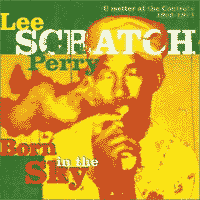
LEE SCRATCH PERRY
BORN IN THE SKY (Fast CD006)
Wait! Another new Lee Perry album, you exclaim. When is there enough? Perry is one of the original geniuses of twentieth-century music, though his contributions were in producing more than writing music. Lately he has reinvented himself as a performer and is truly entertaining and clearly enjoying the celebrity, but his work at the Black Ark studio in the early seventies is the high watermark of reggae. One reviewer commented that as time wore on the ganja clouds in the mixing booth left sticky deposits on the tape heads which muddied the sound. Lee Scratch Perry BORN IN THE SKY is not merely another compilation (I mean with ARKOLOGY, OPEN THE GATE, and the Upsetter collections, what more could you want?). The compiler David Katz is the author of PEOPLE FUNNY BOY: THE GENIUS OF LEE SCRATCH PERRY (Payback Press). This album comes from Perry's recently unearthed masters and includes 8 previously unreleased tracks. They date from 1974 and feature The Ethiopians, the Silvertones (previously unissued) & the amazing Versatiles. "Ungrateful Set" by the Versatiles has a weird xylophone lead, totally different from "The thanks we get"- the version with Louie Davis, Junior Byles and Perry's infant son Omar heard on CURLY LOCKS. If that wasn't enough reason to get this, it's followed by a goofy dub of the later version with pots-and-pans percussion (Move over Harry Partch).
We return to earth briefly with a tasty pop song, Susan Cadogan's "Do it Baby" with a truly whacked wordless backing vocal by Bunny Rugs. I can't get enough of this one! The tight arrangement is by organist Glen Adams who had returned from Brooklyn to play with Perry (& cavort with Cadogan) in 1974. It's a contrast to the freeform antics of the dubs, but shows that Perry could turn on the hit machine if he wanted to.
The instrumentals show Gladdy Anderson, Val Bennett and other fine performers working out, we also get to hear Perry's quirky lyrics and ad libs. Another discovery is "Lady Lady" by Cinty and the Monkees. Only referred to as "a certain Cynthia" she appeared at a 1974 session for a cover of the Chi-Lites song. That became the basis for Scratch's "Enter the Dragon," an alternate take of which follows. Perry's own bottom-heavy "Bury the Razor" and dub (leased from Trojan) masterfully relocates the air molecules in your space. Definitely one to show off your subwoofer. The tune is "Feel alright" which returns in an acoustic rehearsal by The Silvertones. To close we get a second unreleased take of Cinty and the Monkees doing "Lady Lady." You can get this one on CD or double album if you prefer.
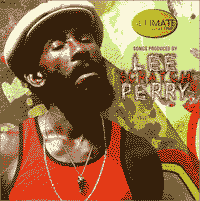
LEE PERRY
THE ULTIMATE COLLECTION
Lee Perry fans won't be much excited by the latest release from the Black Ark archives called THE ULTIMATE COLLECTION. There is only one track on here that is not widely available: that is Dillinger's toast over Junior Murvin's "Roots Train," but it was enough to make me get the album. Everything else on here is not only on other compilations but on several other compilations. However, if you don't own the three-volume ARKOLOGY, this is a must have as it does contain the essential tracks produced by Scratch in the seventies. I wish they had included some rarities, just one or two, but as it is, it is a pleasant set reminding us once again of the daring of this recording innovator who would randomly throw switches in the booth, consigning a lovely vocal track to oblivion, while bringing up the bass, twisting the background harmonies around with echo and reverb, giving too much attention to the drummer's feet and occasionally slicing in nyabinghi drums or tiny fractions of vocal utterances to really mess with your brain. You don't need to smoke collie weed to appreciate this: it's a very psychedelic experience just listening to it on headphones.
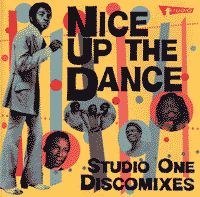
VARIOUS JAMAICANS
NICE UP THE DANCE (Heartbeat)
Ezra Pound, translating a maxim of Confucius, said, "Make it new." Part of the marketing impetus behind CDs (or DVDs, or other "improved" technology) is to make you want what you already have by repackaging and creating a newness to familiar material. You may not have listened to your record albums in a while but you think fondly of them, so when the marketers suggest you can renew your enjoyment by getting an extra morsel out of them that you previously missed, you are moved to consume again. Out on CD for the first time, though it was previously available in other forms, comes NICE UP THE DANCE, a collection of Studio One disco mixes on Heartbeat, with eight extended mixes from the classic reggae label "guaranteed to fill the dance floor."
Honestly, I don't know how well they'd work on a dance floor today, but I am still very happy to have these rocksteady ballads and classic dubs from the roots. Although there's no Slim Smith, Pat Kelly or John Holt, there are half a dozen of the best singers of their generation, including Horace Andy, Ken Parker and Delroy Wilson.
Cornell Campbell's "Queen of the Minstrel" starts out like the record is out of round, but soon you realize it has a whirling momentum unlike any other song, with the punctuation of the Sound Dimension horn chorus and a chirpy organ riff. Originally issued in 1969, the song was reworked with added instrumental overdubs for the 12-inch single and eventually became a staple of reggae deejaydom.
Ken Parker was a soul singer who also recorded gospel albums. "My whole world is falling down" was his number one hit from 1969. Here it clocks in at 8 and a half minutes of throbbing bliss. Freddie McKay is best known through his Studio One album, PICTURE ON THE WALL which also includes the gems "High School Dance" and "Love is a Treasure." That latter song is presented here in a long jam with the Soul Defenders (I think) providing the groove. His mournful voice floats off ethereally in the version (he sounds like he's crying in the bathroom).
Horace Andy is still riding the charts thanks to his collaboration with Massive Attack. One of his big Studio One hits was "Mr Bassie." Here's the long version you always wanted to hear. The great Delroy Wilson who, although he was very talented, had a sad career, checks in with "Give Love a Try." The title cut, Michigan and Smiley's effervescent "Nice up the Dance," comes bubbling along on the irresistible "Real Rock" rhythm recorded by Sound Dimension and done in a dubwise style by the Soul Vendors. This is one track that would work well on the dance floor today. It signaled the return of Studio One to prominence in the 1980s as producers saw the value in their old rhythm sides for cutting new singles. According to Chris Wilson, 70% of all new Jamaican songs released in the last thirty years are versions of Studio One rhythms! Although this was actually piracy it brought the trove of classic Studio One rhythms to the awareness of a new generation. The tune is so catchy it was versioned (at Studio One) by Willie Williams ("Armagideon Time"), Half Pint, Dillinger, Windew Haye, Mikey Jarrett, Eagle Man, Johnny Osbourne ("Lend me the sixteen"), Tennasee and Silvertones, and the Lone Ranger ("You too greedy"). On my beat-up but treasured copy of Michigan and Smiley's RUB-A-DUB STYLE, I wrote the titles of the Paragons' and Heptones' songs they remade so I could make my own extended mixes. This is a game deejays love to play and many's the cassette I filled with versions of popular Jamaican rhythms.
Speaking of popular rhythms, Alton Ellis' "Baby can I change my mind?" floats over Jackie Mittoo's wicked groove "Keep on Dancin'." The relatively unknown Viceroys close out the set in a new mix of one of their songs, "Slogan on the Wall," which has been collaged together with Tommy McCook's instrumental version.
NICE UP THE DANCE is a mellow companion to the STUDIO ONE SHOWCASE that Heartbeat released in 1999, also featuring rare 12" mixes of Jamaican hits of the seventies.
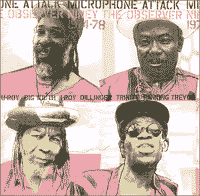
NINEY THE OBSERVER
MICROPHONE ATTACK (Blood & Fire BAF CD037)
If you aren't hip to Jamaican deejay music (for some reason) then check out the latest Blood & Fire release MICROPHONE ATTACK by NINEY THE OBSERVER 1974-78. You'll discover, among other things, how Blood & Fire got their name (from a 1971 rhythm track with a wicked bottom), and the centrality of U-Roy to the live performance of deejay music and its acceptance as a legitimate form as it evolved from arbitrary interjections at the beginning of a tune or mere backtalk wisecracks over a pre-recorded vocal. The personality of the deejay was the basis for the cults surrounding each of the new figures emerging on the musical scene in Kingston in the late 1960s. This is long before Kurtis Blow and Grandmaster Flash pioneered rap in the USA .
On the other hand, Jamaican borrowings from American music were also fertile ground, so it is a two-way street. Soul Syndicate (who backed Dennis Brown) adapted the Memphis sound of Willie Mitchell heard on the great hits of Al Green. You can pick up on riffs as diverse as the Drifters' "On Broadway" (Dennis Brown's "Take a Trip," presented here as I-Roy's "Fresh and Clean") or a personal favourite, The Archies' "Sugar Sugar" (reprised in Big Youth's "Four Sevens"). The Niney songs gathered here were mainly versioned over hits by Dennis Brown, but Brown's vocals are reduced to a secondary role, providing some occasional colour to the vigorous toasting of the cream of Jamaica's dancehall. There are four tracks from Big Youth, and nine from I-Roy (who died last year), plus a few assorted one-offs. Some really fabulous reggae songs were deconstructed by Niney (& his rivals like Scratch and Tubby). Junior Byles' "Weeping" is one of those unforgettable moments. There are two I-Roy toasts over it here, including a "slack" version with suggestive lyrics. This is followed by two more back-to-back versions over a rhythm most famously used as the basis for Greg Isaac's "Slavemaster." The second version, "Camp Road Skanking" is a wry political satire and has I-Roy playing the gormless cockney tourist looking for birds, unaware that Camp Road barracks has been turned into a detention centre. I never tire of the Abyssinians' "Satta" rhythm and here's another recut featuring Leroy Smart singing "Jah is my light," doubled up with the B-side of the 12": I-Roy giving us "Wicked Eat Dirt," a blend of Amharic and snippets of the Psalms.
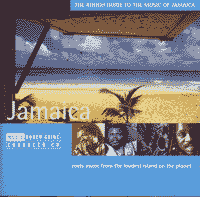
VARIOUS JAMAICANS
ROUGH GUIDE TO JAMAICA Rough Guide RGNET 1056 CD)
The outstanding new Rough Guide (this week) is a Big Up Rootical Rasta Ting called JAMAICA. Rough Guide had the sense to bring Steve Barrow aboard as the selector. Without being didactic he has vetted the incredibly diverse legacy of the world's loudest island and given us a selection that is representative without being predictable. While there are five cuts licensed from Blood & Fire (Barrow's post-Trojan venture), there are also many cuts from Greensleeves, Bunny Lee, Clive Chin and Heartbeat. These present a balanced and unusual glimpse of the music of Jah. The sequence is chronological. Laurel Aitken kicks things off with "Mas Charlie (Prisoner Song)" which sounds like calypso but is actually a folk/mento song. From the early sixties we hear a shuffle blues and the Maytals' "John & James": a ska classic that shows why Toots Hibbert rules with his vocal style. The tempo doesn't let up as we get an instrumental from Baba Brooks to show where jazz riffs intersect the island consciousness. Phyllis Dillon represents the plethora of great women singers from Jamaica with "Don't stay away," her maiden rocksteady voyage from Duke Reid's studio. Lord Creator is the first pleasant surprise on the album. His ballad "Such is life" has the undercurrent of real hardship that makes songs of sufferation so compelling. (It's better to hear about it than experience it but we can empathize.) Chapter and version is dealt with via the Temptations' "Everybody Needs Love" -- here delivered by John Holt, the version from Roland Alphonso. Simultaneously these cuts show the parallel development of Jamaican soul and R&B with North America. I've always felt Jamaica had plenty of singers who could stand alongside Al Green, Marvin Gaye and Wilson Pickett as classic crooners.
Another island stalwart, the late great saxophonist Tommy McCook, leads Impact All-stars in a jazzy rendering called "Jaro" which was also the basis for Augustus Pablo's first melodica hit "Java." The same rhythm keeps rolling for I-Roy's rap "Hospital Trolley." Bunny Lee's famous "flying cymbal" sound rides under Cornell Campbell's version of the old spiritual "We shall not be moved," called "I shall not remove."
There's no Marley or Perry, but just as vital Dennis Brown comes coasting in over the "Real Rock" rhythm with a plea for unity. The next surprise is Lopez Walker. I though it was Burning Spear at first. Walker is a fine if obscure singer who made a few sides in the 70s (You can also hear him on the Chantells CHILDREN OF JAH). As Barrow says, "This beautiful song, with its telling biblical imagery, might well serve as valediction for the roots era of the seventies."
The obligatory hymn to the weed is up next: Triston Palma's "Spliff tail." The echoey sound includes a whirr that sounds like an engine with a loose fanbelt.
Junior Reid's "Boom Shack a Lack" paved the way for the digital dancehall sound of the mid-eighties. Linn drums and a heavily synthesized bass anchor the sound ominously. A trio of dancehall hits rounds out the set without getting too heavy. The last cut by Luciano, who is still in his twenties, indicates the direction of the "new roots" school of Jamaican music. It closes the compilation nicely with a strong lyric which has added soprano sax weaving around the voice. This is a densely packed album with no false moves. Props to World Music Network for taking on this task of getting Jamaica down to one hour of music, and doing it so effectively.
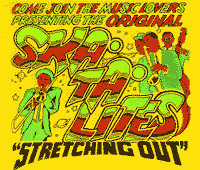
SKATALITES
STRETCHING OUT (RE141 double CD)
This previously only-on-cassette recording by the legendary fathers of Ska, reunited after a decade hiatus in July 1983, is a crucial juncture of jazz, soul, and Jamaican pop. Their old telepathic interplay intact, they rediscover cornball standards like "I'm in the Mood for Love" or the theme to "Guns of Navarone." Part of the fun is hearing the soloists, particularly Tommy McCook on tenor, quoting nutty phrases from other songs, unsuccessfully trying to derail the melody which lopes along with the infectious ska beat, held together by Lloyd Knibbs on drums and Lloyd Brevett on upright acoustic bass. Some very off-key vocals and droll patter by Lord Tanamo highlight the casual, go-as-you-please ambiance. They've mostly joined the ancestors now, but enjoyed a brief reprise and toured with dwindling original members. However, they were in full effect (with the sad exception of trombonist Don Drummond) when I saw their Ūrst reunion tour at Slim's in San Francisco in the mid-eighties. Roland Alphonso and Tommy McCook shared center stage. The rhythm section of Lloyds looked so beat-up, wild-haired and snaggle-toothed, you got the feeling you'd cross the street if you saw them coming towards you, but nobody had chops like these cats. Many of the members were orphans who had met and learned brass instruments at the Alpha Boys home in Kingston. As youths, they took Mento, Burru drumming, and other folk rhythms and revamped them, then the versatile horn players would lay on with catchy tunes drawn from Hollywood or the Beatles, or their own compositions with topical titles like "Lee Harvey Oswald," "Fidel Castro," "Christine Keeler," or "Nuclear Weapon." The incredible earthy Jackie Mittoo on keyboards was just the icing on the cake and the Skatalites ended up backing every act in Jamaican popular music from the mid-sixties on.
Highlights of their early career can be found on FOUNDATION SKA (Heartbeat CD 185/6), licensed from C.S. Dodd's Studio One label, ORIGINAL CLUB SKA (Heartbeat CD 55) which also includes some of the outstanding early vocalists who worked with them, and SHUFFLIN ON BOND STREET (Trojan CDTRL275) which shows the derivation of Ska from R & B and its evolution into Rocksteady.
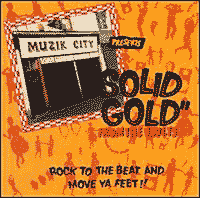
MUZIK CITY PRESENTS SOLID GOLD FROM THE VAULTS (TRLS 291)
When I see yet another Trojan reissue, I can't believe that it can maintain the standards of the Trojan Producers series. Apparently, however, the early '70s was a time when anyone with talent could get before a mike and cut a song, so there are seemingly unlimited fine tracks by otherwise obscure artists, and another batch are included on MUZIK CITY PRESENTS SOLID GOLD FROM THE VAULTS. Dave Barker, who kicked off the Lee Perry SHOCKS OF MIGHTY compilation, comes back rapping "Shocks 71" on the dub of the Wailers' "Small Axe." Winston Williams delivers a couple of tasty toasts, including "People's Choice" over Slim Smith & the Uniques' "Ain't too Proud to Beg." A rocksteady ballad from Stranger Cole and two cuts from the Bleechers cool the pace on side one. Side two kicks off with Herman doing an organ instrumental "New Love," based on the classic Techniques riff, "You don't care." There are a couple of average instrumental cuts plus the version side of the Maytals' "Walk with Love." "Skanky Dog" is Winston Scotland's toast over "Maga Dog," and though the album is heavy on the toasting, the music carries it. (This album was followed by three more compilations, from the vaults.)
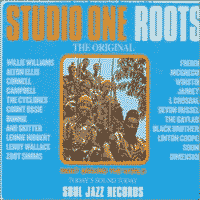
VARIOUS ARTISTS
STUDIO ONE ROOTS (Soul Jazz Records)
I checked out a new reissue on the Soul Jazz label called STUDIO ONE ROOTS. It seemed at first glance like another repackaging of thoroughly gone-over material (like their STUDIO ONE SOUL compilation) but this one does have surprises. The selectors decided to pick tracks from Coxsone Dodd's archive that they felt demonstrated his commitment to Rastafarianism. This seems like an odd approach, since Studio One is not known as a roots label, however they dug up the proof. The CD seems to have been mixed to push up the bass 'n' drums. After a bubbly organ instrumental (waiting for you to skin up?) we get into Freddie McGregor's "Africa Here I come" which rides the "Pass the kutchie" riddim. "Lumumbo" by Bunny and Skitter showcases Count Ossie who first brought the rootical Kumina drumming to Jamaican music, with Prince Buster's "Oh Carolina." After the success of that song musicians turned increasingly to Buru music that gradually twisted R&B into rocksteady and reggae. We get deep inna yard for some seventies action from Lennie Hibbert ("More Creation") and L. Crosdale who is backed by Drumbago and the Rebel Group for "Set me Free" which was apparently recorded at the Roundhouse in London, and not at Brentford Road.
Surprisingly Burning Spear is not included on this album, but Winston Jarrett renders up "Fear Not" which rides the Sound Dimension rhythm that Spear used for "Rocking time," so he's here in spirit. The album peaks with a moody "Drum song" by Devon "Soul" Russell (instrumentalized by Jackie Mittoo on EVENING TIME), then, after the familiar "Africa" of the Gaylads with its bird calls, drifts into what I'd term filler. This CD proves that Coxsone Dodd was more than tolerant of Rastafari (he was the only producer who allowed musicians to smoke ganja in the studio) and once again that his house bands, Brentford All Stars and Sound Dimension were polished musicians not afraid to get out of the A-minor E-minor bag and stretch out.
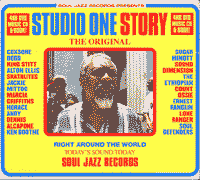
VARIOUS ARTISTS
STUDIO ONE STORY
(Soul Jazz Records)
At this point it's safe to say there are no musical treasures waiting to be unearthed in the Studio One vaults: we've heard it all (more than once with all the versioning that went on). So then, why put out another album that goes from the Skatalites' "Guns of Navarone" to Delroy Wilson's "Dancing Mood" to the Abyssinians' "Declaration of Rights", then Tommy McCook, Sugar Minott, back to Skatalites' "Man in the Street", Jackie Mittoo and Lone Ranger? Well, in this case there is a reason. The package includes a DVD shot in Kingston telling the Studio One story. In it, the rather laconic Coxone Dodd rambles on about his life and work in excruciating detail, and occasionally someone else pops in to tell part of the story. Alton Ellis, Ken Boothe and other luminaries are interesting. The big surprises are Sister Ignatius, sixty year veteran of the Alpha Boys School (the orphanage where the Skatalites met and learned music), talking with trumpeter Dizzy Moore (on his best behaviour), a short clip of Count Ossie's drummers on a bandstand, and some amusing clips from travelogs and newsreels about Jamaica in the 60s, including newsreel footage of the arrival of Ethiopian Emperor Haile Selassie in Kingston, and his amazement at the legions of dreadlocked drummers awaiting H.I.M. The story is well-documented, particularly with the historical clips that have been unearthed, but a bit self-indulgent.
Hand-held footage of Coxone walking down the street with a cohort of sexagenarians -- who fifty years ago were the rude boys on the corner -- reminding him that his sound system was Number One, get repetitious. Interviews with surviving studio musicians Eric "Rickenbacker" Frater (someone tranquilize that boy!) and Earl "Bagga" Walker are rambling. As Alton Ellis put it, Coxone was stiff and straight but the music had the "lick," the street sound with imperfections, which was thanks to keyboard/arranger Jackie Mittoo. Ellis also stresses the importance of Mortimer Planner, leader of the Rastafarian movement in Jamaica, who was sent to Africa by the government in 1972 with a delegation of Jamaicans to suss out the rasta scene there. His yard was the meeting place for the Wailers, Burning Spear, the Wailing Souls and others, who would do three things: read the Bible, smoke the herb, and make music.
If you can't get enough of the surprisingly bashful Lone Ranger, or Dennis Alcapone, or the curiously disfigured Winston Spakes (AKA King Stitt), there are added outtakes from their interviews. The handheld video work is not very good and the editors worshipfully parade every known photo from every album cover, and apply gimmicky little framing tricks. Devotees of course, will ignore me, and run out and get it. The accompanying 90-page booklet is pretty hopeless too because they ran solid color tints behind the old grainy photos so now you can't see anything in them at all. While this documentary is worth seeing, it's clear this story remains to be told, and about half this footage is useful to that end. Given the possibility for interviewing some of the major Studio One participants who are still alive (and touring), it's a shame the Soul Jazz posse didn't try to catch the fabulous Heptones or Abyssinians in concert (at Sunsplash or one of the summer tours in the USA) and talk to Leroy Sibbles (who invented the Studio One bass-line by copying the pianist's left hand), Lee Perry, Johnny Osborne, John Holt, Burning Spear, Carlton Manning, Toots Hibbert, or Marcia Griffiths. There's a whole lotta dem still out there.
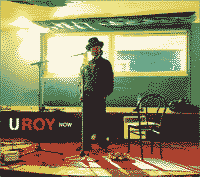
U-ROY
U-ROY NOW (Beatville)
U-ROY is back and big as he ever was on U-ROY NOW, a Beatville record. U-Roy (Ewart Beckford) first made his mark with King Tubby in the mid-sixties. Tubby's was the first sound system to have a Space Echo with which he could add echo, decay and reverb to instrumental sides of songs and U-Roy, Dennis Alcapone, Big Youth and others pioneered the deejay toast or stream-of-consciousness monologue over the riddim, voicing concerns from the dancehall scene to the larger world outside. In the seventies, U-Roy ruled the roost at Treasure Isle, versioning all the top acts of the day, like John Holt and the Paragons, the Jamaicans, the Melodians and the Wailers. U-Roy has been touring again and has come back strong with an album of familiar songs in new versions recorded with different backing bands. There are guest vocalists too, so the whole package comes off like a showcase of great reggae.
Errol Dunkley leads off with "OK Fred," a classic from the Bluebeat era. Then the full rootical might of reggae descends with Anthony B doing a credible Peter Tosh impression on the immortal anthem "Equal Rights & Justice." ("Everybody wants to go to heaven, none a-them -- nobody -- wants to die!"). When B sings "What is due unto Caesar, give it, give it unto Caesar," U-roy interjects "Caesar would a love that!" Another Wailers' classic, Bunny Wailer's "Dreamland" is up next. I had forgotten what a great song this is. "Come on come on," a ska duet with Horace Andy, is the first disappointment: It doesn't seem complete.
Things pick up again with "I'm Still in Love," a fine turn from Alton Ellis (which has U-Roy quoting Althea and Donna) and "I've got the Boogie" with Strange Jah Cole (A version of "Boogie in my Bones," it's also done by Laurel Aitken, another tireless trouper). A pair of classics originated by Greg Isaacs and backed by Roots Radics, who were on the original recordings, round out the CD. "Wanted" is sung by Sugar Minott who sounds like the Cool Ruler and phrases this mellow ditty beautifully. The great Max Romeo steps up to the mike for "Material Man." Cat Coore from Third World on harmonica adds a lot of atmosphere to this moody version. There's an odd mix of electro-funk and roots on the closing cut "Nyabinghi Chant" (originally recorded by Cedric Brooks) with Sly & Robbie and the Taxi Gang. For certain they could have dumped the synth on this and stuck to the congas. Despite a little flatness in the middle, this is a truly classic CD which new and old fans of new and old reggae will enjoy.
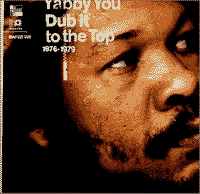
YABBY YOU
DUB IT TO THE TOP 1976-79 (Blood & Fire CD 038)
Like other Blood & Fire releases, this has creative design and informative packaging and the music is augmented with out-takes are rare tracks. "Dub it to the Top" combines 1977's "Yabby You meets Michael Prophet" with 7 B-side dubs by Yabby from the same period and a 12" mix featuring Tommy McCook. The key here is Osborne Ruddock, aka King Tubby, at the controls in one of his finest hours. In contrast the B-sides included were mixed by Prince Jammy. Yabby is here in his role as producer, and the vocalist is reduced to instrumental color in a wash of bottom-heavy riffs with horn sorties coasting in the echo chamber atop fine organ from Touter, and conga playing by Skully Simms, along with other members of the Aggrovators. Unless you are a dub fan this may be too spare for you. Dubwise it's King Tubby in his best era and another worthy digital restoration from Blood & Fire.